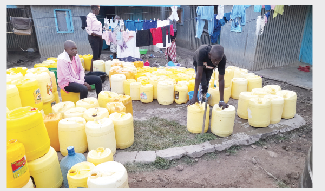For Karachuonyo women, a trek to Lake Victoria is the only option
By Noven.Owiti, February 8, 2023Up until abo An acute water shortage has hit thousands of people in Karachuonyo Constituency due to the prolonged drought.
Residents of North Karachuonyo, Kibiri and West Karachuonyo wards are bearing the brunt of the ravaging effects of drought that has left water sources dry.
Consequently, they have to trek for more than 8km to look for the previous commodity in Lake Victoria.
The residents draw water from the lake at Lwasi beach which is the nearest source of the commodity.
Donkeys are the main means of transport.
Mercy Awuor and Nancy Aketch say they have to wake up early to look for water.
“Water shortage is a big problem in Karachuonyo, particularly during the dry seasons,” Awour says.
Besides walking long distances to draw water from the lake, residents take most of the household washing such as laundry and kitchen utensils to the lake.
They also take bath in the lake to save water at home.
Aketch expressed fears of an outbreak of waterborne diseases.
“Many people consume the lake water directly without treating it,” Aketch said.
Security threat
Koredo assistant chief David Opere said water scarcity in the area is a security threat, particularly to women who have to walk in the dark to fetch water.
“Some donkeys collapse and die due to exhaustion. Women also risk becoming victims of rape because they wake up in the wee hours of the morning,” Opere said.
He urged the government to construct water pans in the villages to reduce the distance they cover in search of water.
The Homa Bay County government plans to dig boreholes in each ward as a way of addressing the water problem.
MCAs have approved a supplementary budget from the water department to allocate Sh3 million for boreholes in their wards. Homa Bay has 40 wards.
“The shortage of water in Karachuonyo is a major concern. We want construction of boreholes fast-tracked to remedy the situation,” said North Karachuonyo MCA Ouma Odongo.
Clifford Omondi, a climatologist, attributes the extreme drought to the effects of climate change.
Omondi says the droughts are the result of change in weather patterns.
“Climate causes abnormal precipitation and other times triggers drought when the contrary happens,” he says.
According to Omondi, destructive human activities such as cutting down of trees is also to blame for the change in weather patterns.
Reduction in tree cover, he says, contributes to low rainfall and moisture.
“Right now there is high evaporation due to excessive heat and therefore we are losing a lot of moisture in the atmosphere causing drought,” he says.
As a mitigation measure, the environmental expert urges county governments to integrate climate change issues in their development blueprints.
Omondi says county administrations should formulate policies and regulations that support the fight against impact of climate change.
Such regulations, he says, would enable the devolved units to lobby for resources to provide services that tackle the effects of climate change.
“The governors must ensure that there are proper mechanisms on how to conserve the environment and fight the impact of climate change,” he says.
Similarly, he stresses the need to protect water reservoirs and rain catchment areas.
“As a collective responsibility we have to plant more trees to increase the tree cover. This will minimize continuous evaporation hence reduce loss of moisture in the atmosphere,” Omondi explains.
He also calls for adaptation measures, warning that the devastating effects will be felt for a long time.
He urges farmers to adapt to the erratic weather patterns by planting drought resistant crops varieties to ensure sustainable food production.
“The climate change effect is a new normal that is not going anywhere soon. It means the residents may have to be resilient as they go about their activities,” he states.
